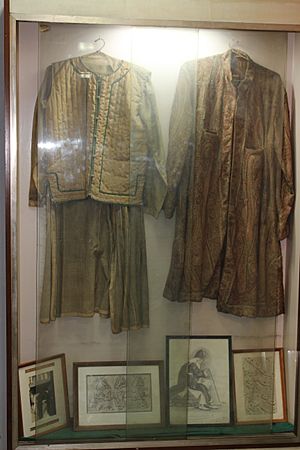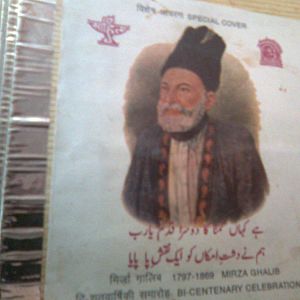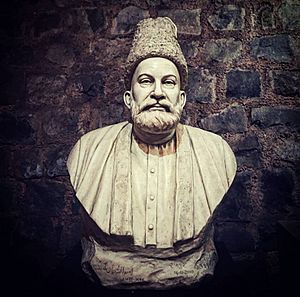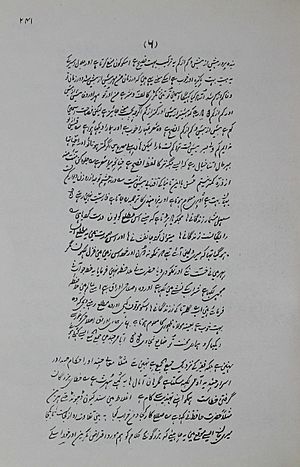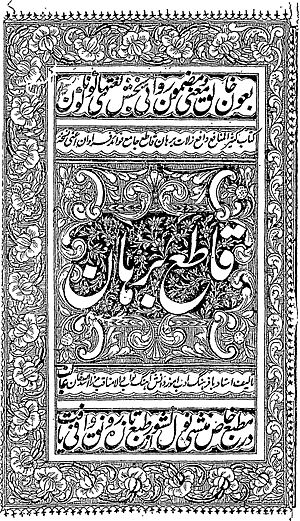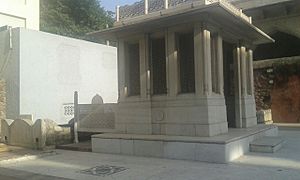Ghalib facts for kids
Quick facts for kids
Mirza Ghalib
|
|
|---|---|
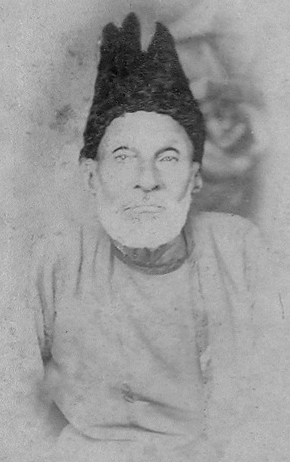
Ghalib in 1868
|
|
| Native name |
مرزا غالب (Urdu)
|
| Born | Mirza Asadullah Baig Khan 27 December 1797 Kala Mahal, Agra, Maratha Confederacy |
| Died | 15 February 1869 (aged 71) Gali Qasim Jaan, Ballimaran, Chandni Chowk, Delhi, British India |
| Resting place | Mazar-E-Ghalib, near Nizamuddin Dargah, Delhi |
| Pen name | |
| Occupation | Poet |
| Language | Urdu, Persian |
| Period | Mughal era, British Raj |
| Genre | Ghazal, Qasida, Ruba'i, Qit'a, Marsiya |
| Subject | Love, philosophy, mysticism |
Mirza Asadullah Baig Khan (1797-1869), better known as Mirza Ghalib, was a famous Indian poet. He used the pen names Ghalib and Asad. He was also given special titles like Dabir-ul-Mulk and Najm-ud-Daula.
Ghalib lived during a time of big changes in India. The powerful Mughal Empire was ending, and the British East India Company was taking over. His writings often describe these changes.
He wrote poetry in both Urdu and Persian. Even though he wrote more in Persian, he is most famous for his amazing Urdu poetry. Today, Ghalib is loved by people not just in India and Pakistan, but also by people of Indian origin all around the world.
Contents
Mirza Ghalib's Early Life
Mirza Ghalib was born in Agra, India. His family were Mughals who had moved to India from Samarkand (which is now in Uzbekistan). His grandfather, Mirza Qoqan Baig, came to India during the 1700s. He worked in different cities before settling in Agra.
Ghalib's father, Mirza Abdullah Baig, married Izzat-ut-Nisa Begum. He worked for different rulers but sadly died in a battle in 1803. Ghalib was only five years old then. His uncle, Mirza Nasrullah Baig Khan, then raised him. But his uncle also passed away in 1806.
In 1810, when Ghalib was thirteen, he married Umrao Begum. He then moved to Delhi with his younger brother, Mirza Yousuf. Sadly, none of Ghalib's seven children lived past infancy. Ghalib often wrote about life being a difficult journey in his poetry.
He once wrote:
|
قید حیات و بند غم ، اصل میں دونوں ایک ہیں |
The prison of life and the chains of sorrow are the same. |
Titles and Royal Connections
In 1850, the Mughal Emperor Bahadur Shah Zafar gave Mirza Ghalib the title Dabir-ul-Mulk, which means "secretary of state." He also received the title Najm-ud-daula, meaning "star of the state." These titles showed that Ghalib was now part of Delhi's important noble families. The Emperor also called him Mirza Nosha, which allowed him to add "Mirza" to his name.
Ghalib was an important person in the Emperor's royal court. Since the Emperor himself was a poet, Ghalib became his poetry teacher in 1854. He also taught Prince Fakhr-ud Din Mirza, the Emperor's oldest son. Ghalib was also chosen to be the official historian of the Mughal Court.
Ghalib came from a noble family and never had to work a regular job. He lived on money from the Mughal Emperors, or from his friends. He became truly famous after his death. He believed that future generations would recognize his talent. After the Mughal Empire ended and the British Raj began, Ghalib tried many times to get his full pension back, but he never succeeded.
Ghalib's Literary Journey
Ghalib started writing poetry when he was just 11 years old. His first language was Urdu, but he also spoke Persian and Turkish at home. He learned Persian and Arabic from a young age.
When Ghalib was 14, a traveler from Iran named Abdus Samad stayed at his home for two years. This traveler taught Ghalib a lot about Persian, Arabic, philosophy, and logic.
Even though Ghalib thought Persian was more important than Urdu, his fame comes from his Urdu writings. Many scholars have written books explaining Ghalib's ghazals (a type of poem). Before Ghalib, ghazals were mostly about sad love. But Ghalib used them to talk about philosophy, life's challenges, and its mysteries. He wrote ghazals on many different topics, making this type of poetry much broader.
In his poems, Ghalib often kept the identity of the person he was writing about unclear. This allowed him to write about the "idea" of love rather than a specific person. This made his love poems more about the feeling of love itself.
Ghalib's Letters
Mirza Ghalib was also a brilliant letter writer. His letters helped make Urdu prose (regular writing, not poetry) simpler and more popular. Before Ghalib, Urdu letters were very fancy and complicated. He made his letters "talk" as if he was having a conversation with the reader.
Ghalib once said:
|
ہزار کوس سے بہ زبانِ قلم باتیں کرو |
From a thousand miles, talk with the tongue of the pen, |
His letters were very informal and often funny. He wanted his readers to enjoy what he wrote. Some experts believe that Ghalib would be famous just for his letters alone.
Ghalib lived through a difficult time. He saw many famous markets and areas of Delhi disappear. The beautiful mansions of his friends were destroyed. Ghalib wrote that Delhi had become like a desert. He described it as a "military camp." It was the end of the old noble way of life that Ghalib belonged to.
He wrote:
|
ہے موجزن اک قلزم خوں کاش یہی ہو |
An ocean of blood churns around me - Alas! Was this all? |
His Pen Name
Ghalib's first Takhallus (pen name) was Asad, which means "lion." This came from his given name, Asadullah Khan. Later in his poetry career, he also chose the pen name Ghalib, which means "all conquering" or "superior."
A Journey to Kolkata
Ghalib's poetry impressed the Mughal Emperor Bahadur Shah Zafar. But when the British took more control, the Emperor became a British pensioner, and Ghalib's own pension was stopped. This led Ghalib to travel a long way to Kolkata (then Calcutta) to ask the British Governor-General to restore his pension.
This journey greatly changed Ghalib's writing. He fell in love with Kolkata. He wrote about his stay there in a work called Safar-e-Kalkattah. Before this trip, he mostly wrote in Urdu, but after visiting Kolkata, he started writing more in Persian. He realized that the literary world in Kolkata was more open and flexible than what he was used to in Delhi. He attended many literary gatherings that were not formal court events.
His time in Kolkata broadened his ideas about writing. He became a well-known poet there, receiving both praise and feedback. During this period, he wrote two long Persian poems: Chiragh-e Dair (Lamp of the Temple) and Bad-e Mukhalif (Adverse Winds). His letters show how much he loved Kolkata. He called the city a place that could fix anything except death.
Ghalib and Sir Syed Ahmad Khan
In 1855, Sir Syed Ahmed Khan, a famous scholar, finished his detailed book about the Ai’n-e Akbari, a historical record. He asked Ghalib to write a foreword for it. Ghalib wrote a short Persian poem. In it, he criticized the Ai’n-e Akbari and the old Mughal culture it represented. He suggested the book had little value and praised the "sahibs of England" instead.
This poem was unexpected, but it came at a time when Sir Syed Ahmed Khan was already thinking about changes in India. Ghalib seemed to understand that the world was changing, especially with the British influence. Sir Syed Ahmed Khan might have been annoyed, but he probably realized Ghalib's view was largely correct. After this, Sir Syed Ahmed Khan stopped focusing on history and became a social reformer.
Ghalib's Beliefs
Ghalib believed that finding God was more important than just following religious rituals. He followed Shia Islam and wrote many verses praising Alī ibn Abī Ṭālib.
Ghalib wrote:
|
ہے پرے سرحد ادراک سے اپنا مسجود |
The object of my worship lies beyond what we can understand; |
Like many other Urdu poets, Ghalib wrote deeply religious poetry. However, he was sometimes doubtful about how some religious leaders interpreted Islamic teachings. He disliked the narrow-mindedness and hypocrisy of certain religious scholars.
He once wrote about a religious preacher:
|
کہاں مے خانہ کا دروازہ غالبؔ اور کہاں واعظ، |
What's the connection between the Preacher and the tavern door? |
During the rebellion in Delhi, British soldiers questioned Ghalib. When asked if he was Muslim, Ghalib cleverly replied, "Half?" When asked what he meant, he said, "I drink wine, but I don't eat pork." This showed his witty nature and how he saw himself.
Poems Praising Muhammad
A large part of Ghalib's poetry includes Naʽat, which are poems praising the Prophet Muhammad. This shows that Ghalib was a devoted Muslim. He wrote a long poem called Abr-i gauharbar as a Naʽat. He also wrote a qasida (another type of poem) of 101 verses dedicated to a Naʽat. Ghalib saw himself as a humble person not worthy of directly addressing the Prophet, who was praised by God.
Ghalib's Persian Works
Ghalib thought very highly of the Persian language and was proud of his knowledge. Most of his Persian poems were qasidahs written for the rulers who supported him. He also wrote ghazals and mathnawis in Persian. His first published Persian work was a collection of poems called May-ḵāna-ye ārzū in 1845.
He also wrote prose works, like Panj ahang, published in 1849. Mehr-e nīmrūz, published in 1855, was a history of the world up to the death of Mughal Emperor Humayun. Another historical work was Dastanbu, which was his personal account of the 1857 revolt. Ghalib's last major Persian work was Qaat'i-e Burhaan, a critical review of a Persian dictionary.
In 2010, a collection of over 11,000 Persian poems by Ghalib was published. He wrote more Persian poems than Urdu poems during his lifetime.
Friends and Students
Ghalib's main rival was the poet Zauq, who was the teacher of Emperor Bahadur Shah Zafar. They sometimes joked and competed with each other. However, they respected each other's talent. Both also admired Meer Taqi Meer, a great Urdu poet from the 18th century. Another poet, Momin Khan Momin, was also a famous contemporary of Ghalib.
Altaf Hussain Hali, a very important figure in Urdu literature, was a shagird (student) of Ghalib. Hali also wrote a biography of Ghalib called Yaadgaar-e-Ghalib.
Ghalib was not only a poet but also a great prose writer. His letters show the political and social life of his time. They also mention many of his friends, like Mir Mehdi Majrooh, who was also a good poet.
Ghalib's poems were sometimes hard to understand. He would make the sentences very complex. Once, another poet named Aish Dehlvi mocked Ghalib in a poem:
|
اگر اپنا کہا تم آپ ہی سمجھے تو کیا سمجھے |
It's not good if only you understand what you say. |
Ghalib felt a bit sad about this and wrote:
|
نہ ستائش کی تمنّا نہ صلے کی پروا |
I don't wish for praise, nor do I care for reward. |
This unique style was part of what made him special. In prose, Ghalib started a new trend in Urdu literature. He created an easy, simple, and beautiful way of writing, making it feel like a conversation.
Ghalib's Grave
Ghalib was buried in Hazrat Nizamuddin in Delhi, near the tomb of Nizamuddin Auliya.
Ghalib's Legacy
Mirza Ghalib passed away in Delhi on February 15, 1869. The house where he lived in Old Delhi, known as the Ghalib ki Haveli, is now a museum dedicated to him.
Many famous singers have sung Ghalib's ghazals, including Jagjit Singh, Mehdi Hassan, Lata Mangeshkar, and Nusrat Fateh Ali Khan.
Films and TV Shows About Ghalib
A film called Mirza Ghalib was released in 1954. Bharat Bhushan played Ghalib. The music, featuring Ghalib's ghazals, is still very popular.
A Pakistani film named Ghalib was released in 1961. It starred Sudhir as Ghalib.
Gulzar produced a TV series called Mirza Ghalib in 1988. Naseeruddin Shah played Ghalib. The ghazals in the series, sung by Jagjit Singh and Chitra Singh, became very famous.
Stage Plays About Ghalib
Ghalib's life has been the subject of hundreds of plays performed in India and Pakistan. These plays explore his life and relationships.
One famous play is Qaid-e-Hayat (Imprisonment of Life, 1983) by Surendra Verma. It talks about Ghalib's personal life, including his money problems. Another popular comedy is Ghalib in New Delhi, which has been performed over 300 times.
Ghalib's Poetry in Films
The 2015 film Masaan includes many examples of Ghalib's poetry. The film's writer, Varun Grover, wanted to show a character who enjoys reading Hindi and Urdu poetry. This is a common hobby for young people in Northern India, especially when they are in love.
Google Doodle
On December 27, 2017, Google honored Ghalib on his 220th birthday. They showed a special doodle of him on their Indian homepage.
Statue in Jamia Millia Islamia, Delhi
A statue of Ghalib was placed in Jamia Millia Islamia in Delhi in the early 2000s. It shows Mirza Ghalib as a great Urdu poet.
Wall Mural in Mumbai, India

On January 21, 2019, a large wall mural of Mirza Ghalib was unveiled in Mumbai. The mural shows Ghalib's life and his impact on poetry and art in India.
Images for kids
-
Mirza Ghalib's tomb near Chausath Khamba, Nizamuddin area Delhi
See also
 In Spanish: Mirza Ghalib para niños
In Spanish: Mirza Ghalib para niños
- Ghalib Study Centre, Ibn Sina Academy
- Ghalib Academy, New Delhi
- Mirza Ghalib College, Gaya
- Ghalib Museum, New Delhi
- List of Persian poets and authors
- Persian language in the Indian subcontinent
- List of Urdu language poets
- Urdu poetry
- Mirza Ghalib poetry


